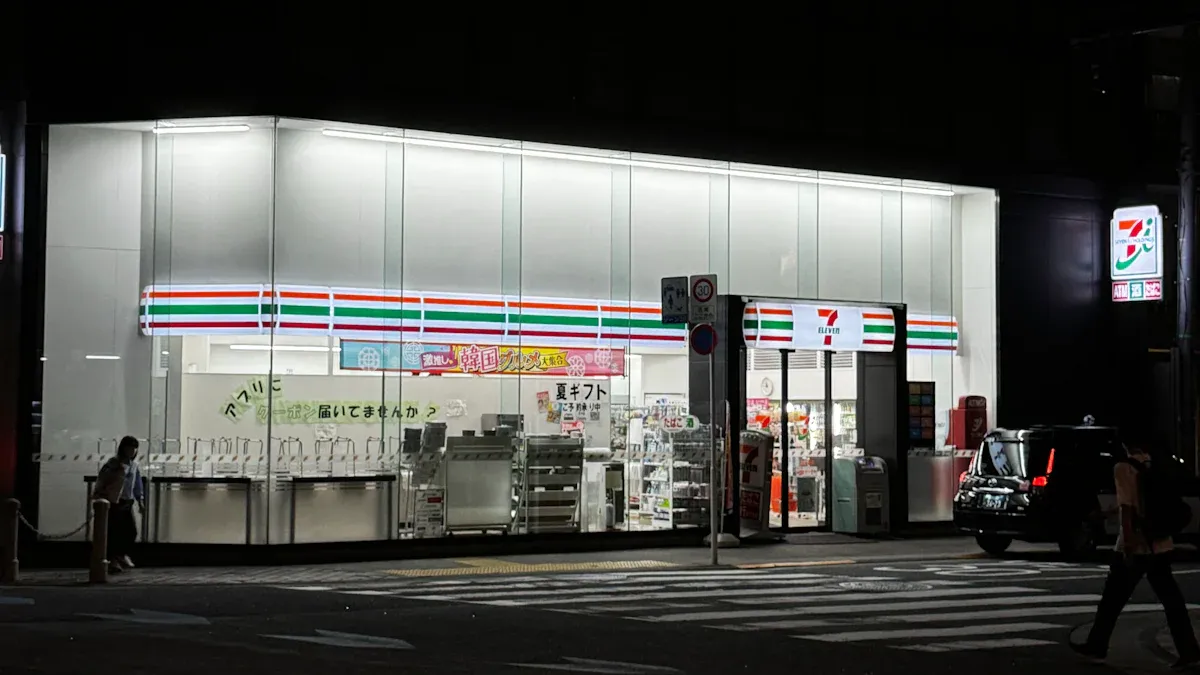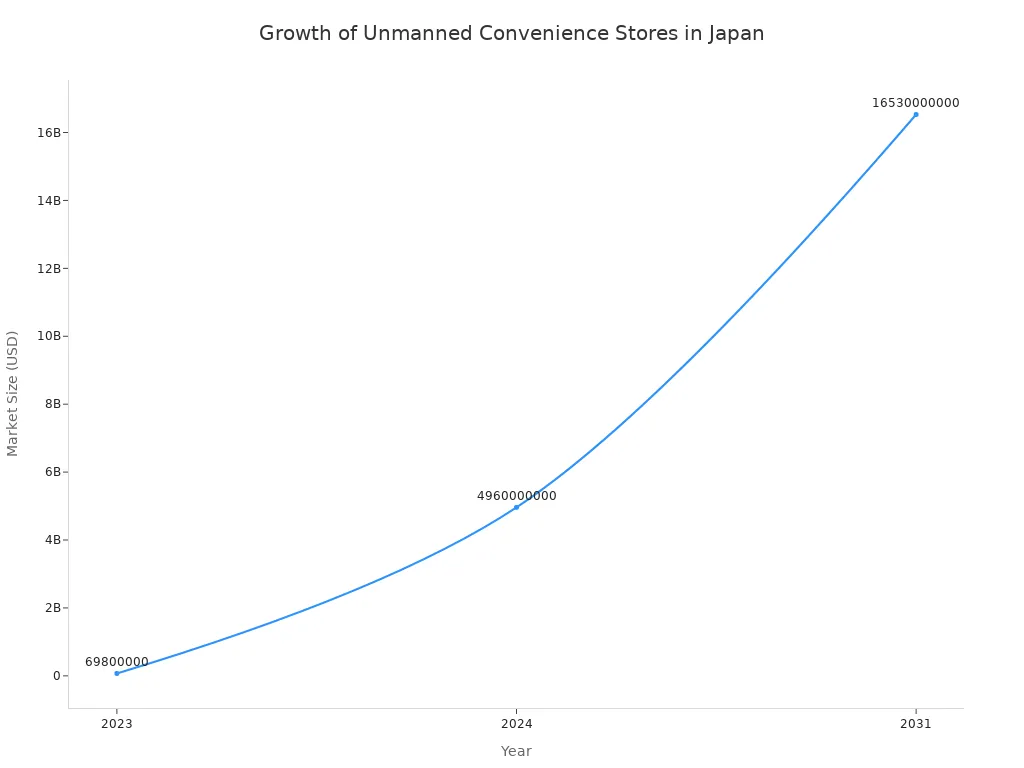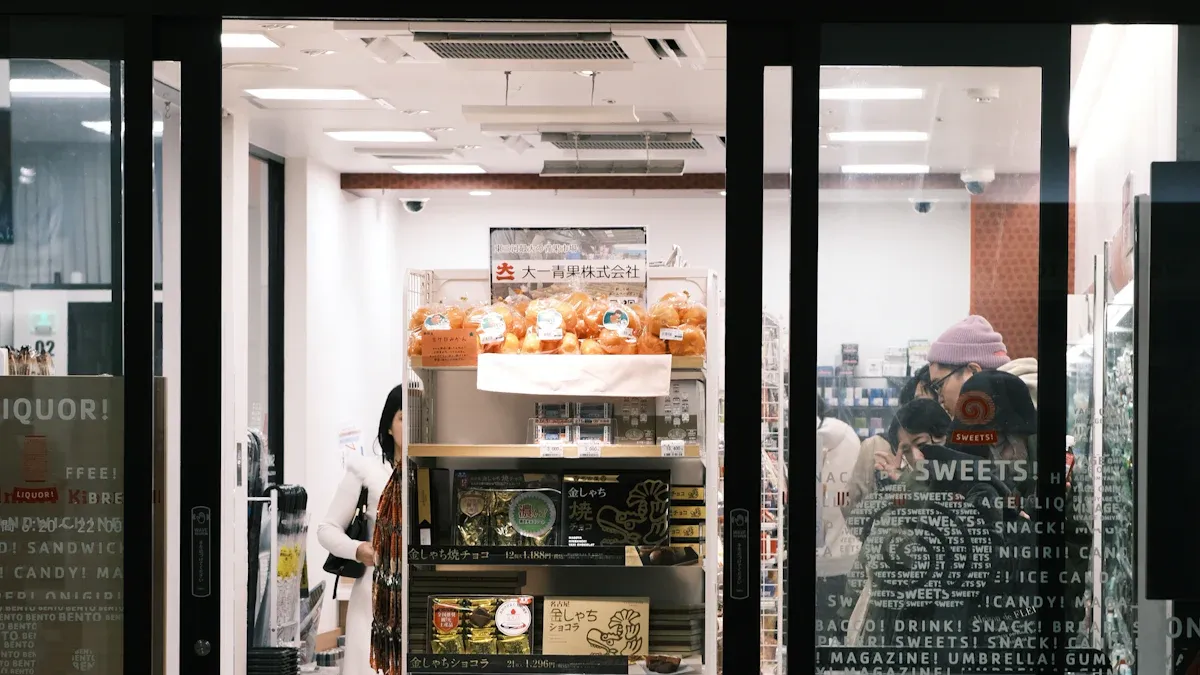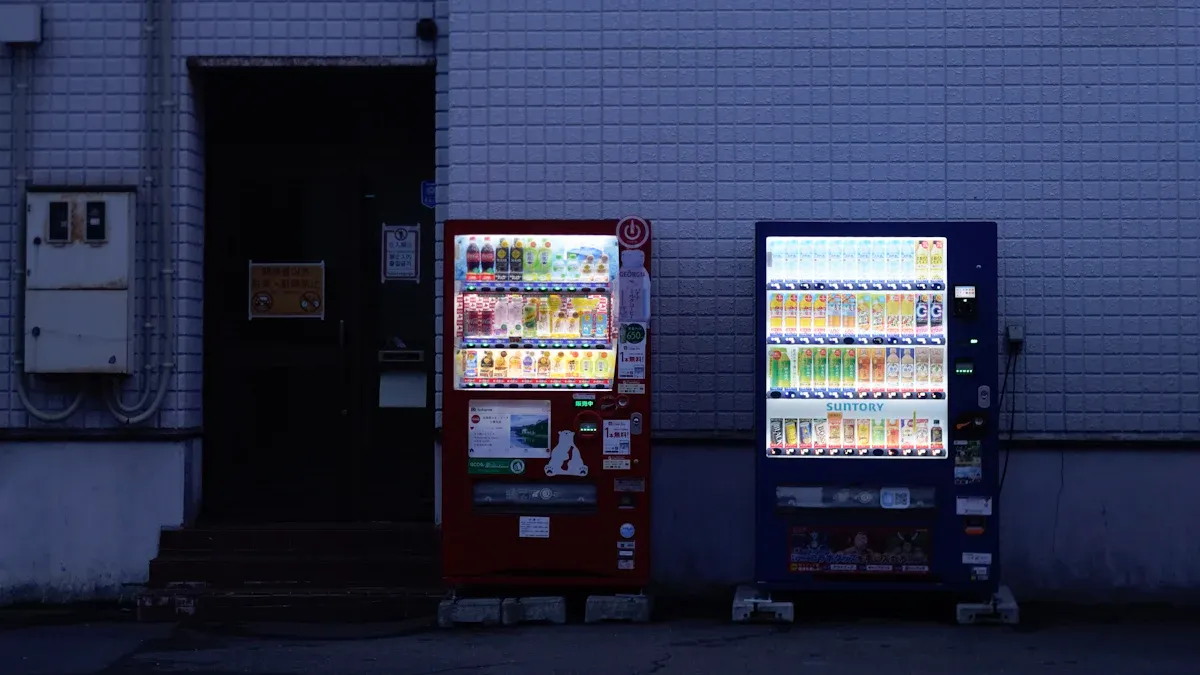How AI and Automation Are Shaping Japanese Convenience Stores

You can go into a Japanese convenience store and see no workers at the counter. Stores without staff are showing up in many places. This is because there are not enough workers and new automated store technology is being used. AI avatars answer your questions, and one worker can look after many stores at the same time. Seven-Eleven thinks it will use 30% less daily labor with these systems. As automated store technology grows, you get quicker service, shorter lines, and shopping that feels like the future.
Key Takeaways
Japanese convenience stores now use AI and automation more. This helps with not enough workers and makes shopping better for people. Automated systems, like AI cameras and RFID technology, help customers shop faster. They also make shopping safer and easier. Robots put items on shelves and help count products. This lets stores work well with less staff. More stores now have no workers and use contactless shopping. This gives customers an easy way to shop. In the future, stores in Japan will be even smarter. AI will guess what customers want and make service better.
Automation Trends in Japanese Convenience Stores
Drivers: Labor Shortages and Consumer Needs
Japanese convenience stores are changing fast. This is because there are not enough workers. People also want better shopping experiences. Many store chains use robots and AI to help with these problems. Robots and AI help stores save money and need fewer workers. For example, 7-Eleven uses robots to cut down on workers by 30%. The Japanese government is working with five big store chains. They want to have 50,000 automated stores by 2025. In stores like Lawson and FamilyMart, you can see cooking robots and avatar clerks. These changes help stores work well even with fewer workers.
Shopping is getting better because of AI. AI helps stores plan what to buy and how to set up shelves. AI looks at what people in the area like to buy. Stores use real-time sales data to decide what to sell. Seasonal items show up at the right time. This makes you want to come back. AI tools check the weather and local events to guess what people will buy. This helps stores waste less food and save money.
Here is a table that shows what shoppers want from these stores:
Consumer Need | Description |
|---|---|
Convenience | You want to get products quickly and easily. |
Enhanced Speed | You want fast service and quick shopping. |
Streamlined Checkout | You like checking out fast with little waiting. |
Safety | You feel safer in stores without workers, especially after COVID-19. |
Labor Cost Management | Stores use automation to keep prices low even with fewer workers. |
Interaction with Retailers | You get better help and information from AI systems. |
Rise of Unmanned and Contactless Stores
Unmanned and contactless stores are becoming more common each year. The market for these stores in Japan was $69.8 million in 2023. It grew to $4.96 billion in 2024. Experts think it will reach $16.53 billion by 2031. The chart below shows how much the market is growing:

You see new technology when you go into these stores. Face recognition lets you enter without touching anything. AI and 3D cameras watch where you go and what you pick up. Payment terminals show what you bought. You pay with cash or electronically. Barcode scanners help if there is a payment problem. Automated store technology makes shopping faster, safer, and easier for you.
Automated Store Technology in Action

AI Cameras and Intelligent Sensors
When you enter a Japanese convenience store, you see cameras and sensors. These are not only for security. They help stores learn what you like and how you shop.
The IMX500 sensor counts people who look at digital signs. It also checks how long you look at them.
The AITRIOS platform gathers data about how you view ads. It keeps your privacy safe.
Edge AI technology sees how many people look at signs and for how long. This helps stores pick the best ads.
The IMX500 sensor sends this data to computers. Stores use it to choose what to sell.
These smart systems do more than watch. They help stop shoplifters right away. For example, the Vaakeye system caught a thief in Yokohama. Stores with AI cameras have less shoplifting, up to 77% less. You feel safer, and stores lose less money.
Tip: AI cameras and sensors help stores keep shelves full and make shopping safer.
RFID and Automated Checkout
RFID means Radio Frequency Identification. This technology changes how you pay in Japanese convenience stores. Avery Dennison makes these RFID tags. The Japanese government and five big store chains want all stores automated by 2025. Some RFID tags can go in the microwave, so you can heat food without removing the label.
Aspect | Details |
|---|---|
Initiative | Government wants stores automated by 2025 |
Collaborating Companies | Five big convenience store companies in Japan |
Technology Implementation | RFID helps faster shopping and better inventory control |
Customer Experience | You scan products for info and checkout is quick, about five seconds |
Theft Prevention | RFID tags stop theft by keeping doors closed if items are unpaid |
RFID tags make checkout very fast. You put items on a scanner, and it reads all tags at once. Paying takes about five seconds. You wait less in line. Stores use RFID to stop theft. If you try to leave with unpaid items, the doors stay closed.
Aspect | Impact on Transaction Speed | Impact on Customer Satisfaction |
|---|---|---|
Operational Efficiency | Increased | |
Wait Times | Lowered | More satisfaction |
User Experience | Fun | Personalized service and trust |
You get more product information. Stores can give you special deals. Real-time updates help you trust the store and make shopping fun.
Robotics and Inventory Management
Robots help keep shelves full and stores running well. You might see robots like TX SCARA and Model T in the aisles.
Robot Type | Functionality | Tasks Performed |
|---|---|---|
TX SCARA | Restocking | Scans shelves, finds low stock, and restocks drinks with over 98% accuracy. Uses AI for planning and remote help. |
Model T | Shelf-stacking | Tested for restocking drinks, with plans for rice balls and sandwiches. Staff can control it from far away. |
The TX SCARA robot scans shelves and restocks drinks. It uses AI to plan its path and can be controlled from far away.
The Model T robot is tested at FamilyMart stores. It starts with drinks and will soon handle other foods. Staff can control it remotely, which helps when there are not enough workers.
Robots help stores stay open all day and night. They keep products fresh and lower waste by tracking inventory. Stores using robots can make five times more profit. They save money by making fewer mistakes and stopping theft. Automated store technology works like a "silicon shopkeeper." It stocks, cleans, and helps with checkout. You always find what you need, even late at night.
Note: Automated store technology helps stores save money and serve you better, any time.
Leading Examples of Automation

Lawson’s Real x Tech Store
Lawson’s Real x Tech Store uses automated store technology. AI cameras watch what you pick up. They suggest discounts just for you. Digital signs show product details and talk about sustainability. Robots fill shelves and make food, so items stay fresh. At checkout, virtual avatars help you pay. They also check your age for restricted products. You get quick service and special recommendations. The store has 14 AI cameras to learn your shopping habits. This makes your visit easier.
Tip: If you have questions, ask the virtual avatar for help with products or payment.
Feature | Benefit for You |
|---|---|
AI Cameras | Personalized suggestions |
Digital Signage | Product and sustainability info |
Robots | Fresh food and stocked shelves |
Virtual Avatars | Fast checkout and age verification |
FamilyMart and CloudPick Partnership
FamilyMart works with CloudPick to use unmanned retail technology. You walk in, pick up what you want, and pay without staff. AI, sensors, and cameras keep the store safe. They make payment easy for you. The system tracks inventory and helps you find products fast. You get a shopping experience made just for you. This is because the store uses AI and IoT technologies. Shopping is faster and more efficient with this partnership.
You shop by yourself and leave when you finish.
AI and sensors keep the store safe and handle payments.
Inventory stays correct, so you find what you need.
Expansion Beyond Convenience Stores
Automated store technology is now used in other places in Japan. Logistics companies use robots to move pallets and track packages. Daiwa House spends billions on new buildings with transport and inventory robots. Ramen shops and cafés use unmanned models. These include self-checkout machines and AI-powered surveillance. Lawson has a store where you pay by walking through, no scanning or waiting. Restaurants use robots to bring food to your table. Many businesses offer more choices and faster service.
Logistics robots move goods and help stop mistakes.
Cloud-based platforms help manage data in healthcare and logistics.
Note: Automation helps stores and businesses serve you better, even when there are not enough workers.
Impact on Shoppers and Retailers
Convenience and Personalization
Japanese convenience stores are easier to shop at now. Automated store technology uses AI to make shopping fast. You get suggestions for products you might like. You can pay quickly with special payment systems. There is no need to wait in line or talk to a cashier. Robots keep shelves full and help you if you need it. Stores want your shopping to be smooth and fun.
AI looks at what you buy and suggests products for you.
Fast payment systems let you finish shopping in seconds.
Robots help keep track of products and show you where things are.
Shopping is easy and fits your busy life.
AI-powered loyalty programs make you visit stores more often. You feel happier, with more people liking their shopping. Smart stores let you grab items and leave fast. This saves you time.
Privacy and Security
You might worry about your information being safe. Japanese convenience stores use strong security systems and follow strict rules. AI cameras watch the store to stop theft and keep you safe. Special technology helps make shopping secure.
Source | Description |
|---|---|
Retail Sector: The Rise of Unmanned Stores in Japan | Stores use strong security and protect your privacy. |
Cloudpick and Lawson's smart convenience store launch in Tokyo | AI and sensors watch stores to stop theft and keep you safe. |
You can shop knowing your privacy is important.
Accessibility and Inclusivity
Automated store technology helps more people shop easily. Stores are open all day and night. AI avatars can answer questions in many languages. Stores make shopping easier for people with disabilities. You see wide aisles and clear signs. Everyone can enjoy shopping.
Tip: If you need help, ask the AI avatar for help with products or directions.
Challenges and Limitations
Technical and Operational Barriers
Not every convenience store in Japan uses robots or AI. Many stores have problems with technology and how things work. Some robots cannot do every job. Some need more training to work well in busy stores. Stores must keep systems working all day and night. Power failures or software bugs can stop service. Sometimes, robots move slowly or make mistakes when stocking shelves.
Seven-Eleven Japan works with Telexistence to fix these problems. They are making humanoid robots called 'Astra' to help in stores. These robots use generative AI. They will do simple jobs, so human workers can help you more. Seven-Eleven Japan is testing robots that restock drinks in Tokyo. The goal is to find which jobs robots do best and train AI with real data.
Evidence Description | Details |
|---|---|
Collaboration | Seven-Eleven Japan works with Telexistence to make humanoid robots for stores. |
Purpose | The plan is to automate simple jobs, so workers can help customers. |
Technology | The robots, called 'Astra', use generative AI and may be used by 2029. |
Goals | Find jobs for robots, make robots for real stores, and build data for AI training. |
Current Pilot | Seven-Eleven Japan is testing Telexistence’s drink restocking robot in some Tokyo stores. |
Note: Stores must keep making robots and systems better to help you.
Social Acceptance and Workforce Impact
You might wonder how these changes affect workers and society. Japan has fewer workers because many people are older and there are not many young people. Robots and automation help fill these jobs. Some people worry about losing jobs. Many bosses think there will be fewer jobs for humans alone in the future.
New jobs appear, like Filipino tele-operators who control robots in Japan. This gives work to people in the Philippines, but these jobs pay less than jobs in richer countries. Workers feel stress when they must watch many robots at once.
Filipino tele-operators control robots in Japanese stores.
Many bosses think there will be fewer jobs for humans only.
New jobs in the Philippines pay less and can be stressful.
Society is slowly getting used to automation. People like how easy shopping is, but some worry about losing jobs and fair pay. Stores and companies must use technology and also care about workers and communities.
Global Comparison and Future Outlook
Japan vs. International Automated Stores
Japanese convenience stores are different from stores in other countries. In Japan, stores offer many services. You can use ATMs, print papers, pay bills, mail letters, and buy concert tickets. Some stores even sell clothes. In other countries, stores mostly sell snacks and help with gas. Japanese stores use "omotenashi." This means they try to help you before you ask. Stores in the U.S. and Canada help you only when you need it.
Feature/Service | Japanese Convenience Stores | International Convenience Stores |
|---|---|---|
Range of Services | ATM, printing, bill payments, mailing, concert tickets, clothing | Limited snacks, mainly gas station services |
Customer Experience | Proactive service (omotenashi) | Reactive service model |
Store Density | About 13,000 stores in U.S. and Canada (with recent closures) |
Japan has over 21,000 7-Eleven stores. The U.S. and Canada have about 13,000 stores. Some stores in these countries have closed recently.
Japanese stores use automated store technology. This gives you more choices and better service. You find more stores in Japan. You get more help when you shop.
Future of Automated Store Technology
Shopping will change a lot in the future. AI is making stores smarter. Stores use AI to guess what you want and keep shelves full. Retailers look at real-time data and change quickly. This helps stores work better.
AI helps stores know what people want and keep products in stock.
Automated systems make paying faster and easier.
Robots put products on shelves and deliver items.
AI kiosks and robots help you find things and suggest products.
Automated store technology will keep growing in Japan. You will see faster checkouts and less waiting. Shopping will feel more personal. Japan is ahead in using new technology in stores. Stores will get even smarter and more helpful soon.
Tip: Look for new robots and AI systems in your local store. They will make shopping quicker and easier.
Japanese convenience stores are changing because of AI and automation. Robots and smart systems help make shopping quick and simple. You can shop any time, day or night. There are no long lines at these stores. By 2030, more than 30% of stores will use automated systems. The market for robotic stores could reach USD 3.11 trillion. Retailers use robotics and IoT to make shopping better for you. New trends like computer vision and predictive inventory are coming. Stores will get smarter and give you better service soon.
FAQ
What is an unmanned convenience store?
You enter, pick up items, and pay without talking to staff. AI cameras and sensors track your purchases. You get a fast, easy shopping experience.
How does AI help you shop?
AI suggests products you might like. It checks what you buy and gives you special deals. You see faster checkout and better service.
Are automated stores safe for your privacy?
Stores use strong security systems. Your data stays protected. AI cameras watch for theft but do not share your personal information.
Can you use automated stores if you have a disability?
Yes. Stores have wide aisles and clear signs. AI avatars answer questions in many languages. You get help with directions and product choices.
What happens if a robot breaks down?
Staff or remote operators fix robots quickly. Stores use backup systems to keep running. You still get service even if one robot stops.
See Also
The Future of Retail Lies in AI-Enhanced Stores
Understanding the Growth of AI-Driven Corner Retail Shops
Exploring Features and Advantages of AI Vending Machines
